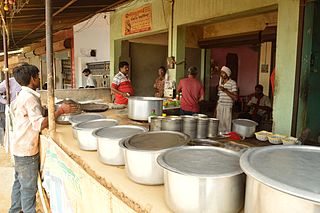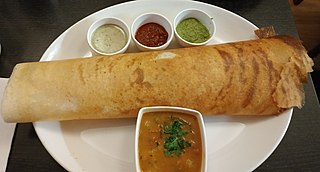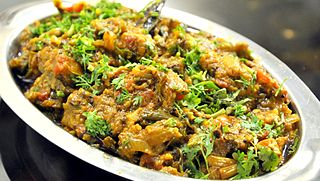
Yogurt is a food produced by bacterial fermentation of milk. Fermentation of sugars in the milk by these bacteria produces lactic acid, which acts on milk protein to give yogurt its texture and characteristic tart flavor. Cow's milk is most commonly used to make yogurt. Milk from water buffalo, goats, ewes, mares, camels, and yaks is also used to produce yogurt. The milk used may be homogenized or not. It may be pasteurized or raw. Each type of milk produces substantially different results.

Ghee is a type of clarified butter, originating from the Indian subcontinent. It is commonly used for cooking, as a traditional medicine, and for Hindu religious rituals.

Punjabi cuisine is a culinary style originating in the Punjab, a region in the northern part of South Asia, which is now divided in an Indian part to the east and a Pakistani part to the west. This cuisine has a rich tradition of many distinct and local ways of cooking.

Dahi vada is a type of chaat (snack) originating from the Indian subcontinent. It is prepared by soaking vadas in thick dahi (yogurt).

Bhatura is a fluffy deep-fried leavened sourdough bread originating from the Indian subcontinent. It is commonly served as a midday meal or a breakfast dish in northern and eastern India. Paired with chickpea curry, it forms a traditional dish called chole bhature.

A dhaba is a roadside restaurant in the Indian subcontinent. They are on highways, generally serve local cuisine, and also serve as truck stops. They are most commonly found next to petrol stations, and most are open 24 hours a day.

Rajasthani cuisine is the traditional cuisine of the Rajasthan state in north-west India. It was influenced by various factors like the warlike lifestyles of its inhabitants, the availability of ingredients in an arid region and by Hindu temple traditions of sampradayas like Pushtimarg and Ramanandi. Food that could last for several days and could be eaten without heating was preferred.

Curd rice, also called yogurt rice, is a dish originating from India. The word "curd" in Indian English refers to unsweetened probiotic yogurt. It is most popular in the South Indian states of Tamil Nadu, Kerala, Karnataka, Telangana and Andhra Pradesh; and also in West Indian states of Rajasthan, Gujarat and Maharashtra.

Indian breads are a wide variety of flatbreads and crêpes which are an integral part of Indian cuisine. Their variation reflects the diversity of Indian culture and food habits.

Matzoon or matsoni is a fermented milk product of Armenian origin found in Armenia and Georgia. The Caspian Sea yogurt commercialized in Japan is said to be the same type of yogurt as matzoon, but a comparison of microbiota and viscosity found that the two are entirely different. Georgian Matsoni has been a protected geographical indication in Georgia since 24 January 2012.
Bhojpuri cuisine is a style of food preparation common among the Bhojpuri people of Bihar, Jharkhand and eastern Uttar Pradesh in India, and also the Terai region of Nepal. Bhojpuri foods are mostly mild and tend to be less hot in terms of spices used. The cuisine consists of both vegetable and meat dishes.

Dahi chutney is strained dahi that is mixed into a chutney of mint and onions, originating from the Indian subcontinent. It is popular in South India and is a side dish along with mirchi ka salan for the popular Hyderabadi biryani.
Awadhi cuisine is a cuisine native to the Awadh region in Northern India and Southern Nepal. The cooking patterns of Lucknow are similar to those of Central Asia, the Middle East, and Northern India and western India with the cuisine comprising both vegetarian and non-vegetarian dishes. The Awadh region has been influenced by Mughal cooking techniques, and the cuisine of Lucknow bears similarities to those of Central Asia, Kashmir, Punjab and Hyderabad. The city is also known for its Nawabi foods.

Baigan bharta, also spelled bainganbharta or baigan chokha is an Indian dish prepared by mashing or mincing grilled eggplant (baigan) with tomato, onion, herbs and spices, with variations being common from chef to chef. Traditionally, cooking the eggplants over charcoals, inside of a tandoor, barbecue grill or oven, or even directly applying flame to the outside of the fruit infuses the dish with a smoky flavour; the blackened skin is then easily peeled and the eggplant may be further prepared.
Bihari cuisine is eaten mainly in the eastern Indian state of Bihar, as well as in the places where people originating from the state of Bihar have settled: Jharkhand, Eastern Uttar Pradesh, Bangladesh, Nepal, Mauritius, South Africa, Fiji, some cities of Pakistan, Guyana, Trinidad and Tobago, Suriname, Jamaica, and the Caribbean. Bihari cuisine includes Angika cuisine, Bhojpuri cuisine, Maithil cuisine and Magahi cuisine. Dal Puri

Aloo tikki, also known as aloo ki tikkia, aloo ki tikki or alu tikki, is a snack originating from the Indian subcontinent. In Indian, Pakistani, and Bangladeshi preparation, it is made of boiled potatoes, peas, and various curry spices. Aloo means potato in Hindi-Urdu, and tikki is a small cutlet or croquette. The dish is served hot along with a side of saunth, tamarind, and coriander-mint sauce, and sometimes dahi (yogurt) or chickpeas.

Maithil cuisine, also known as Mithila cuisine, is a part of Indian and Nepalese cuisine. It is the traditional cooking style of Maithils residing in the Mithila region of the subcontinent.






















